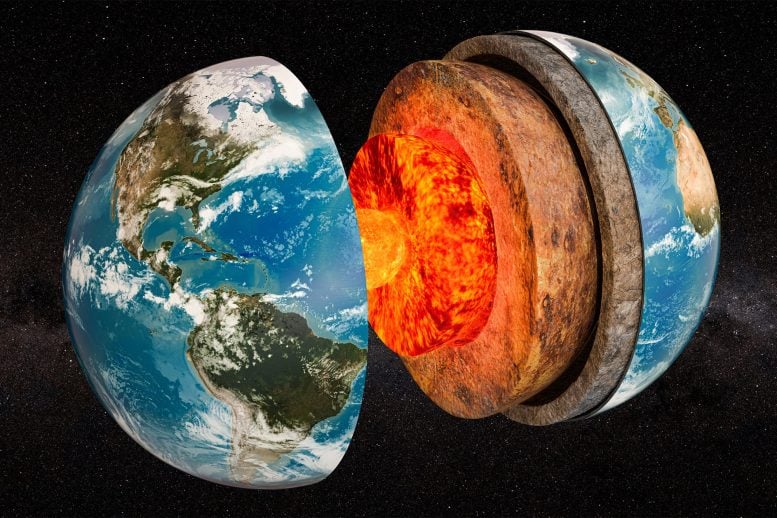
A research team contradicts the prevailing theory of Earth’s crust formation, demonstrating a continual slow reworking rather than a rapid slowdown 3 billion years ago. By analyzing over 600,000 rock samples worldwide, they proposed a new method to chart the Earth’s crustal growth, suggesting a more gradual growth and offering insights into planetary formations and differences, particularly concerning Venus.
For billions of years, the Earth’s crust has continued a slow process of reworking, as opposed to rapidly slowing its growth around 3 billion years ago, a study led by Penn State reveals. The new finding contradicts existing theories that suggest the rapid formation of tectonic plates earlier in Earth’s history, researchers said.
The research was recently published in the journal Geochemical Perspectives Letters.
The work may help answer a fundamental question about our planet and could hold clues as to the formation of other planets, according to lead author Jesse Reimink, assistant professor of geosciences.
“The dominating theory points to an inflection point some 3 billion years ago, implying we had a stagnant lid planet with no tectonic activity before a sudden shift to tectonic plates,” Reimink said. “We’ve shown that’s not the case.”
To chart the formulation of the Earth’s crust — or the crustal growth curve — researchers turned to more than 600,000 samples comprising the Earth’s rock records database. Researchers across the globe — including at Penn State — have analyzed each rock sample in the record to determine geochemical contents and age. Researchers chose the rock records over mineral samples, which informed the theory of a more sudden formation, because they said the rock record is more sensitive and less prone to bias on those time scales.
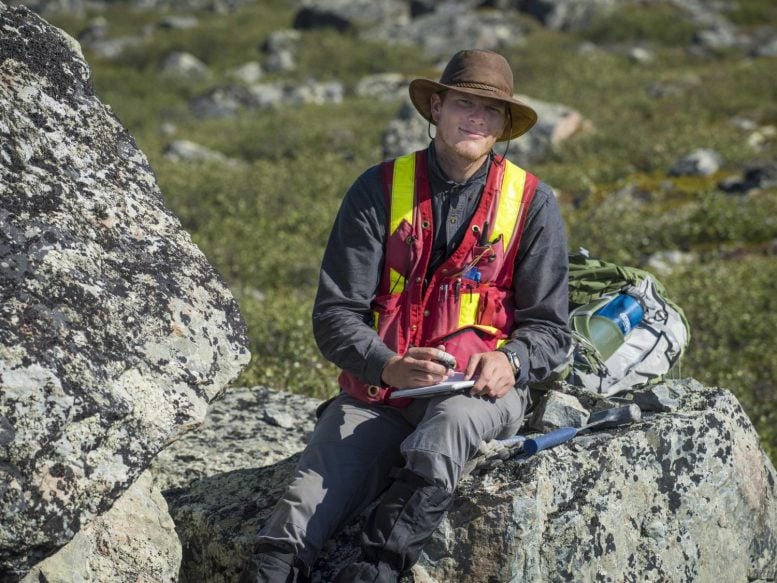
Research led by Jesse Reimink, assistant professor of geosciences at Penn State, suggests that the Earth’s crust continued a slow process of reworking for billions of years, rather than rapidly slowing its growth some 3 billion years ago. The work contradicts existing theories that suggest the rapid formation of tectonic plates earlier in Earth’s history, Reimink said. Credit: Courtesy Jesse Reimink
Knowing that the reliability of the mineral record decreases through time, researchers recreated the crustal growth curve using the rock records. To do that, they developed a unique method for determining how igneous rocks dating to millions of years ago were reworked and reformed over time: experimentally demonstrating how the same rock could change in different ways over time. Rocks can be reformed a number of ways, such as weathering into sediments or being remelted in the mantle, so researchers used this experimental data to inform novel mathematical tools capable of analyzing the rock records and working out the differences in sample changes.
“We calculated how much reworking has happened by looking at the composition of igneous rocks in a new way that teases out the proportion of sediments,” Reimink said.
They used these calculations to calibrate the reworking documented in the rock records. Then, researchers calculated Earth’s crustal growth curve using the new understanding of how the rocks were reformed. They compared the newly calculated curve to the rate of growth gleaned from mineral records by other experts.
Reimink and his team’s work indicates the Earth’s crust follows the path of the mantle — the layer on which the crust sits — suggesting a correlation between the two. It’s not the first time geoscientists have suggested a more gradual crustal growth, Reimink said; however, it’s the first time the rock record has been used to back it up.
“Our crustal growth curve matches the mantle record of growth, so it seems like those two signals are overlapping in a way that they did not when using the mineral record to create the crustal growth curve,” Reimink said.
Reimink cautioned that the research improves on what researchers understand, but it’s not the be-all and the end-all for crustal growth research. There are simply too few data points to speak to the vast time and space of the Earth’s crust. However, Reimink said, further analyzing the existing data points may help inform investigations of other planets. Venus, for example, has no tectonic plates and could be a modern-day example of early Earth.
“When did Earth and Venus become different?” Reimink asked. “And why did they become different? This crustal growth rate plays into that a lot. It tells the how, what and why of how planets evolved on different trajectories.”
Reference: “A whole-lithosphere view of continental growth” by J.R. Reimink, J.H.F.L. Davies, J.-F. Moyen and D.G. Pearson, 3 August 2023, Geochemical Perspective Letters.
DOI: 10.7185/geochemlet.2324
Joshua Davies, of the University of Quebec at Montreal; Jean-François Moyen, of the University of Lyon, France; and D. Graham Pearson, of the University of Alberta, Canada, contributed to this research.
The Natural Sciences and Engineering Research Council of Canada supported this research in part.

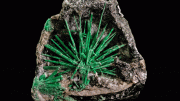

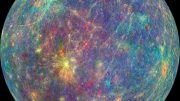
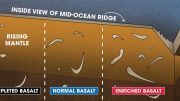
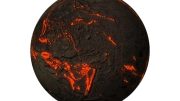
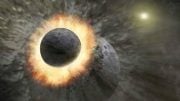
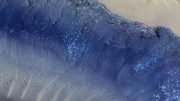
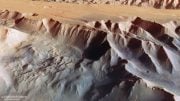
This conclusion does not surprise those who have been working on the Growth, and Expansion of planets for more than 20 years. The process of growth has a feedback loop that getting gradually shorter in elapsed time as time passes. The rate of radius doubling is more than 200 million years when planets are small, but less than 200 million years when the grow larger. The extinction cycle is close to 186.6 million years per Net Galactic Rotational cycle. The Earth, and Venus are both 24.354 X 186.598 million years old. Smaller planets are less than 24.354, and bigger planets are more than 24.354 cycles old. The growth would plot as a gradually upward curving line on 32 cycle Log – Log Paper.
Tell me more
I was writing a long email, and it suddenly vanished. The shorten it. A Base Number raised to the Age = Radius in Meters . That is ( 1.003 XXX xxx ) ^ Age = R ( meters )
The Sun is 31.354 X 186.598 MY old with a radius of 695,508,000 meters. At the far other end is Adrastea at 14.354 X 186.598 and a radius of 8,227.496 meters. Use Natural Logs to solve for the base number. MWC
The Earth, and all the other orbs Grow in Cycles with a period of 186.598 Million Years per Cycle. This is also the extinction event cycle that last showed up 66.043 Ma. Each Cycle has 8 growth periods of varying duration and magnitude as the Solar System passes through all 8 arms of the Milky Way Galaxy. The Sizes of Planets and Moons are in groups based on when they formed, and how old they are. The Cycle is N.354 X 186.598 MY.
The Oldest being the Sun at 31.354 X 186.598 = almost 5850.6 MY. Jupiter and Saturn are 27.354, Uranus and Neptune are 26.354. 25.354 is missing. Earth and Venus are 24.354. Mars and Mercury and 3 Moons are 23.354. Luna and other Moons are 22.354. The Numbers keep decreasing, and the Orbs remain spherical down to 14.354. Below 14.354 they are too small to have a large enough gravity to become spherical. There are more than 90 Orbs in the 14.354 to 31.354 Net Galactic Orbital Cycle groups. I have not yet figured out why the cycle is not around 230 Million years. My Best Guess is that the Solar System counter rotates the MW Galaxy, but who knows. What is strange is that all the Planets, except Mercury, are too large, and the closer the planet is to the Asteroid Belt, the greater the excess radius. For Radius: Venus 101 %, Earth 107 %, Luna 107 %, Mars 111 %, Jupiter 155 %, Saturn 129 %, Uranus 111 %, Neptune 107 %. Notice the Symmetry around the Asteroid Belt for the excess Radius. The Radius in meters should be Radius = ( 1.003 XXX XXX ) ^ ( Planets Age ) = Radius in meters. The numbers for the ” X’s ” get bigger as the Planet ages, thus the feedback loop. The age must be in millions of years. Use Natural Logs to solve for the Base Number. You can start small and young, and the base numbers grows linearly as time passes. Or You can start at the Sun, and the Base Number gets smaller as you go back in time, and Orb Radius. MWC
A star system is not a simple process as assumed. This process is as gradual as dead. Even if some stages in this process may be consequential, each stage is relevant and dead slow, merged into one another and linked together in a large-scale process of billions of years.